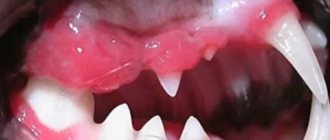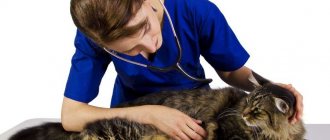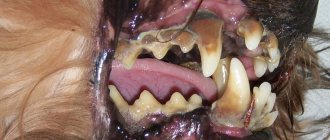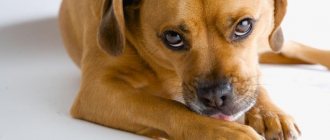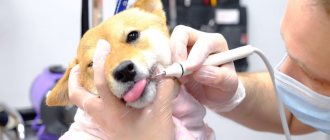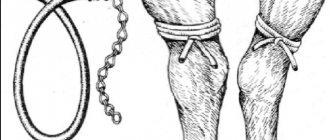Description of the disease
Gingivitis is inflammation of the gums. You can see it by looking at the dog's gums. You will immediately notice that they are noticeably red and swollen.
Gingivitis occurs rarely alone; more often we see inflammation of the entire periodontium (all tissues surrounding the tooth). And, of course, tartar almost always goes hand in hand with gingivitis. Tartar is an unpleasant yellow-brown and sometimes greenish coating on the teeth.
Many people underestimate this pathology - in vain. Gingivitis can have serious consequences.
- Due to the pain (and gum inflammation is undoubtedly a painful process), the dog refuses to eat, which ultimately can lead to exhaustion and metabolic disorders.
- The dog is at risk of losing its teeth if they don’t fall out on their own; in advanced cases, they will have to be removed surgically.
- The inflammatory process, if nothing is done, will continue. First on the palate and pharynx, and then deeper into the digestive tract.
Types of gingivitis
Gum inflammation can be acute or chronic.
The acute process develops quickly and is extremely painful. It occurs as a result of mechanical damage to the gums, with further introduction of bacterial flora, or in cases of acute allergic reaction.
The chronic process does not manifest itself so clearly, but also causes severe discomfort to the dog. It occurs against the background of diseases of the internal systems of the body, disorders of the liver and kidneys, the cardiovascular system, and so on.
Gingivitis can also be local and generalized.
Local is when inflammation covers a limited area of the gum.
Generalized means that the inflammation spreads to the entire surface of the gums.
According to its manifestation, gum inflammation can be purulent, catarrhal, hypertrophic and ulcerative.
Catarrhal gingivitis is the most common. The gums are red and swollen and often bleed.
With purulent gingivitis, there is especially bad breath. Upon examination, you can see the exudate itself (pus) and purulent sacs that have formed in the pockets of inflamed gums.
Hypertrophic gingivitis is characterized by the growth of gums along the teeth. This leads to greater trauma, which further aggravates the inflammatory process.
Ulcerative gingivitis is manifested by the formation of areas of ulceration on the gums, in these places the mucous membrane appears to be exposed.
Causes of gum inflammation in dogs
In veterinary practice, specialists most often encounter the following causes of gingivitis in furry pets:
- Injuries, mechanical damage. Incorrect selection of food (discrepancy between the particle size of dry and solid food and the breed and age of the animal), the habit of gnawing inedible objects (sticks, branches, shoes, etc.) provoke a violation of the integrity of the oral mucosa. The presence of bones in a dog's diet also injures the gums and provokes their inflammation.
- The presence of tartar in an animal is one of the main causes of gingivitis. Deposits on teeth provoke the development of pathological microorganisms and gum inflammation.
- Unbalanced diet. A deficiency in feed of complete amino acids, vitamin A, B vitamins, and ascorbic acid leads to impaired vascular permeability of the oral mucosa and reduces local protective functions.
- Violation of the principles of rational nutrition. Feeding the dog only soft food leads to a decrease in the load on the teeth and gums, which adversely affects their condition.
- Infectious processes in the body. The presence of a focus of inflammation in other organs and tissues often leads to the penetration of pathogenic microflora into the oral mucosa.
- Autoimmune diseases. The cause of the development of gingivitis in dogs, according to veterinary experts, is autoimmune pathologies in which the body produces antibodies to its own cells, including the tissues of the gum mucosa.
- Non-communicable diseases. Diabetes mellitus, liver and kidney diseases can be accompanied by inflammatory processes in the oral mucosa due to impaired tissue trophism.
Decreased immunity is a provoking factor for gingivitis. Allergies and hormonal imbalance can also lead to gum inflammation in dogs. Pathology is often observed in young pets when their teeth change.
We recommend reading about why dogs smell. You will learn about why a dog smells like fish, mice, dog, the causes of bad breath, ears and paws, and options for correcting the situation.
And here is more information about osteomyelitis in dogs.
Risk group
All dogs whose owners do not take care of their pet’s oral hygiene are at risk. Namely, they do not perform hygienic teeth cleaning at home and do not bring dogs to the clinic for ultrasonic cleaning to get rid of tartar.
As for breed characteristics, small breeds of dogs are at particular risk, especially if the dog is already over five years old. This is especially true for individuals with malocclusion.
In large breed dogs, on the contrary, similar problems occur more often before the age of two years, especially during or after changing teeth (at about seven months of age).
Prevention of gum inflammation
Based on many years of practice, veterinary dentists recommend that dog owners adhere to the following rules and tips to avoid gingivitis:
- Carry out hygienic brushing of pets' teeth regularly and correctly. It is necessary to accustom the animal to the procedure from a young age.
- Only high quality food should be used to feed your dog. The size of dry particles should correspond to the age and breed of the pet.
- The animal's diet must be balanced not only in proteins, but also in vitamins and mineral nutrients.
- It is not recommended to constantly feed the animal cereals and soft food.
- To clean teeth from hard deposits, regularly give special bones from tendons, as well as fresh carrots and apples.
- Regularly visit the veterinary clinic and carry out ultrasonic cleaning of teeth from stone.
- Do not allow the animal to chew bones.
- Promptly treat inflammatory processes in the animal’s body.
We recommend reading about gastritis in dogs. You will learn about the causes and types of gastritis in dogs, symptoms, diagnostic methods and treatment options at the veterinarian and at home.
And here is more information about why a dog may refuse to eat.
Gingivitis in dogs most often develops due to dental problems. At the veterinary clinic, the animal will not only undergo ultrasonic teeth cleaning to remove hard plaque, but also remove the diseased tooth if necessary. Conservative treatment methods include treating inflamed tissues with antiseptic solutions, hemostatic and anti-inflammatory ointments and gels, as well as systemic use of antibacterial drugs.
Reasons for development
The first and main reason is lack of oral hygiene. No matter what special treats you give your dog for cleaning his teeth, they will not completely get rid of plaque. Sooner or later, it will mineralize and turn into tartar and lead to gingivitis.
Nutritional reason. Simply put, improper feeding. If you feed your dog bones or low-quality dry food, this can lead to many very serious problems.
The most dangerous of them is gum trauma.
The opposite case is feeding exclusively soft food or various cereals. Such a diet leads not only to the accelerated appearance of tartar, but also to weakening of the gums. They become soft, not in good shape, sometimes even loose.
The pathological state of the body is a disease of internal systems. Especially often, gingivitis is caused by disturbances in the functioning of the kidneys and liver. Metabolic disorders, lack of vitamins and microelements also cause inflammation of the gums and weakening of teeth.
Allergy. Often, allergic reactions can manifest themselves atypically (itching, irritation of the eyes and nose), namely inflammation and swelling in the oral cavity.
Traumatization of oral tissues by foreign objects. Most often these are sticks that dogs play with on the street. This does not mean that you should give up your favorite pastime - the game of throwing a stick to your pet. But it is better to use special toys for this, the choice of which is very wide at present. And of course, inspect your pet’s mouth after walks.
Symptoms of gingivitis
Few owners periodically look into their dog's mouth. Therefore, the first symptoms that people notice when looking at their pet are:
- the dog's breath stinks;
- the dog eats poorly or refuses to eat at all;
- profuse salivation.
When you see these symptoms, you should look into your pet's mouth, and if he has gingivitis, you will see the following:
- red and swollen gums;
- interdental spaces may be bluish;
- gums bleed, sometimes you can see pus;
- if you check your teeth for looseness, most likely they will clearly not sit tightly in the gums;
- with hypertrophic gingivitis - the gum grows on the tooth;
- sometimes you can find ulcers (no need to cauterize them!).
Symptoms
The first sign of a disease that indicates the need to see a doctor is an unpleasant odor coming from the pet’s mouth. Swelling and bleeding of the soft tissues of the gums indicate inflammation. Decreased appetite and refusal to open the mouth indicate the onset of an inflammatory process in the gums. In more advanced stages of the disease, the animal completely refuses to eat, which is caused by increased pain in the mouth.
The development of catarrhal gingivitis is indicated by swollen, swollen gums, accompanied by copious salivation with fragments of pus.
Symptoms that indicate the need to contact a specialist:
- Unpleasant putrid odor from the cavity;
- Excessive salivation;
- Thirst;
- Poor appetite;
- Pain while eating;
- Change in tooth color;
- Swelling of the cheeks;
- Increased temperature, fever;
- Apathetic state;
- Changing regional nodes.
The appearance of blood and pus when pressing on the gums proves that the disease has become chronic.
Diagnostics
A completely correct diagnosis can only be made in a clinical setting. As mentioned above, gingivitis rarely occurs alone, and during diagnosis, all associated problems should not be missed. Only by seeing the full picture of the disease can you help your dog efficiently.
The diagnosis is made based on:
- General examination of the animal.
- Examination of the oral cavity . This point should be approached carefully. When a dog is conscious, especially when experiencing painful sensations, it will resist examining the mouth, and it is unlikely that it will be possible to fully examine all lesions in the oral cavity. Therefore, sometimes the doctor will only be able to see the full picture when the dog is under sedation.
- Special research methods - for example, use the Schiller-Pisarev test. Using a specially prepared iodine solution. The solution is applied to the gums and the color changes are monitored. Thus, the area of inflammation is determined.
- Sometimes an x-ray .
Treatment and therapeutic nutrition
All you can do at home is antiseptic treatment of gums. Take chlorhexidine or furatsilin solution, moisten the bandage generously and wipe the dog’s mouth. You can even gently rinse your mouth with the solution.
Just make sure that the dog does not swallow (it is better to secure it in a lying position).
This procedure will help the dog, but will not solve the problem. Surgery is almost always required, at a minimum, to remove tartar from the teeth. In addition, only under sedation can you see the full picture of the oral cavity.
Treatment directly depends on the cause of gingivitis.
If the reason lies in “internal diseases” - disturbances in the functioning of organs, then you should first overcome them.
Treatment is essentially divided into local and general.
Local treatment is aimed at:
- Teeth cleaning – removal of tartar. If necessary, remove “bad” teeth, which only aggravate the inflammation and spread it.
- Antiseptic treatment of the oral cavity with chlorhexidine or furatsilin solution.
- Anti-inflammatory therapy. For this purpose, special dental gels are prescribed. They must be prescribed by a veterinarian. Don't run to the pharmacy for human remedies because you think it will help.
General treatment:
- Aimed at solving the disease that caused gingivitis.
- Antibiotic therapy. When inflammation is caused by trauma to the gums, pathogenic bacteria enter the body, and antibiotics are prescribed to combat them.
- For a speedy recovery, vitamins are prescribed. Almost always these are B vitamins, and depending on the cause of inflammation, vitamin C or vitamin P may be prescribed.
Also, for a dog with gingivitis, a special diet must be prescribed.
At the height of the disease, this should be soft food from the special Dental therapeutic line. They do not need to be chewed, which means the dog will not experience pain.
If you do not have the opportunity to purchase medicinal food, you can initially feed your dog baby meat and vegetable purees.
This diet must be followed until the treatment begins to bear fruit and the inflammation subsides.
When gum inflammation noticeably decreases and you notice that your dog is more willing to eat. You can switch to wet kibble food. Or if you feed natural food, use boiled meat.
Please note that the meat must be well cooked so that it is tender.
About a month after the start of treatment, you can return the dog to its usual diet.
If you usually feed dry food, then you will have to wait a little while returning it until your pet’s gums are completely restored.
Prevention
You need to brush your dog’s teeth yourself using a special meat-flavored toothpaste and a brush (you can use a human brush with soft or medium-hard bristles). Ideally, the procedure should be carried out every day.
Bring your pet to the veterinary clinic for ultrasonic teeth cleaning once or twice a year.
Adjust your diet to include solid foods. However, do not feed your dog bones. Take a responsible approach to your pet's nutrition!
After walks, examine your pet and observe its condition and behavior. If he's scratching his face with his paw, there's probably something stuck in his teeth. If the foreign object is not removed, it can cause inflammation.
Disease prevention
In order to prevent the development of gingivitis in dogs, it is necessary to take care of the two most important points - quality of nutrition and oral hygiene procedures. It is necessary to regularly brush your pet's teeth using special products and a brush.
It is important to exclude roughage (bones), as well as various sweets from the animal’s diet. Excessive amounts of sugar provoke the destruction of tooth enamel, and hard bones lead to gum injuries. The resulting plaque and tartar are removed in a veterinary clinic. Prevention of tartar - giving special food and toys.
Fresh vegetables in the diet, cut into medium-sized pieces, can prevent the formation of stones.
Strengthening the gums includes regularly giving vitamins and minerals in accordance with the age and breed characteristics of the pet. It would be a good idea to have a preventive examination by a veterinarian in order to promptly identify possible violations.
Inflammation of the gums in dogs is a common cause of bleeding and painful sensations in the mouth. Without timely treatment, disruption of tissue structures leads to the formation of ulcers and purulent wounds. By promptly responding to the first signs of gingivitis, the pet owner will be able to prevent the development of complications. Otherwise, the animal will suffer and may even be left without teeth.
Author and presenter of the column: Veterinarian Nikolay Evgenievich Smirnov
Do you want to know more about the article or something? Call +79774692712, we will advise you.
Briefly about the main thing
- Gingivitis is inflammation of the gums. More often occurs together with stomatitis and other oral problems.
- Depending on the cause and form of manifestation, gingivitis can be acute and chronic, local or extensive, catarrhal, purulent and hypertrophic.
- At home, you can carry out antiseptic treatment with chlorhexidine or furatsilin solution.
- Treatment often requires cleaning under sedation, and sometimes even removal of diseased teeth.
- Gingivitis can be caused by: lack of oral hygiene, injury, and improper feeding.
- Veterinarians diagnose and prescribe treatment for gum inflammation, since it is difficult to conduct a full examination at home.
- Treatment will not be much effort if you deal with the problem in a timely manner.
Have we answered your question fully enough? If not, post your question in the comments below and our veterinarian will answer it.
Did you like the article? Share it with your friends on social media. networks. This will help them get useful information and support our project.
Treatment of gingivitis in dogs
If the above symptoms are detected, the dog owner will need to immediately seek help from a veterinary clinic. There is no need to start this disease under any circumstances. It is impossible to cope with it at home, but it is quite possible to improve the dog’s health.
Veterinarians recommend wiping the teeth of a sick animal with a cotton pad soaked in a weak solution of baking soda; they also recommend rinsing the dog’s mouth with a decoction of sage, chamomile, and oak bark infusion. All of these products have an astringent effect and provide an anti-inflammatory effect. Before carrying out this procedure, you should thoroughly clean the dog's teeth from food debris.
Treatment of gingivitis consists of:
- Complete removal of tartar from teeth.
- Using electrophoresis (heparin solution).
- Taking a course of physiotherapy.
- Gum massage.


